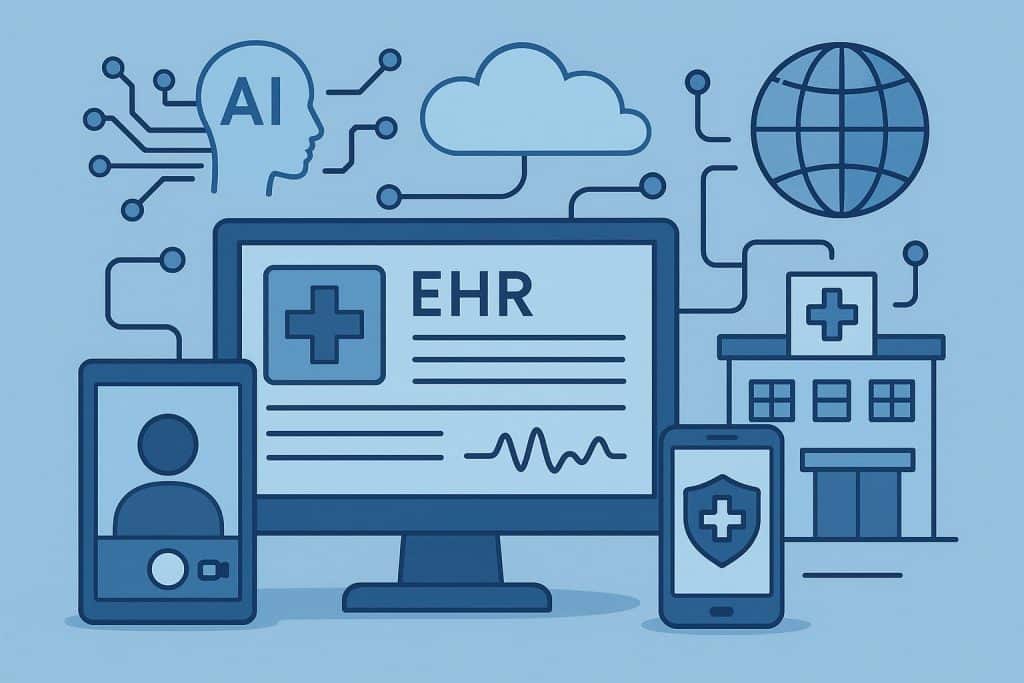Going from a vision of the future, artificial intelligence has become an intrinsic part of healthcare today. With telehealth becoming an inherent part of clinical workflows, AI-native electronic health records are rewriting the way in which providers deliver, manage, and personalize care. From predictive analytics to automation and secure interoperability, AI-driven EHR systems help practices scale telemedicine capabilities and improve patient outcomes.The following are seven keys to how AI-native EHRs are changing telehealth-enabled healthcare practices throughout the industry:
AI-Powered Insights to Improve Clinical Decision-Making
AI-native EHRs drive real-time intelligence into every clinical encounter. By parsing vast volumes of patient data, they generate actionable insights for clinicians, including early warning alerts, treatment recommendations, and diagnostic support. This capability enables doctors to make quicker and more precise decisions, even while practicing remotely through telehealth.
For example, an AI-enabled EHR may be able to identify minute changes in a patient’s vital signs or laboratory results and automatically flag potential health risks. Virtual consultations may trigger immediate interventions based on that insight, averting complications and improving the quality of care across the spectrum.
Streamlining Telehealth Workflows for Greater Efficiency
Managing in-person and telehealth appointments smoothly requires seamless coordination in everything from the initial contact to follow-ups. AI-native EHRs make it easier with the automation of time-consuming administrative tasks. They do this by intelligently matching patients with available clinicians, optimizing the appointment times, and auto-documenting encounter summaries.
These systems also integrate with virtual care tools to ensure that data captured during telehealth sessions directly flows into the patient record, eliminating friction such as manual data entry and giving providers a complete and up-to-date view of each patient’s health journey.
Automating Routine Documentation to Reduce Clinician Burnout
Administrative workload remains a leading driver of physician burnout. AI-native EHRs address this through sophisticated automation and natural language processing. They are capable of transcribing voice notes, summarizing patient interactions, and auto-populating key fields in the medical record — all in real time.
Elation Health is an excellent example of how this technology is put into practice. As a certified EHR software designed for modern healthcare organizations, Elation integrates AI-powered documentation tools directly into its platform, reducing the burden of manual entry and allowing clinicians to spend more time focusing on patient care rather than repetitive administrative tasks. In combining certified compliance with AI automation, Elation Health shows what intelligent EHR solutions can do to make telehealth practices even more human-centered and sustainable.
Improving Patient Engagement and Follow-Up Care
AI-native EHR systems are not only smoothing the way for providers but also improving the patient experience. Through the use of machine learning algorithms, the systems can personalize outreach and reminders, predict appointment adherence, and even identify patients who are at risk of dropping out of treatment.
This is important in a telehealth-enabled practice where the relationship with a provider is often virtual. The ability of a system to remind patients of impending virtual visits, monitor symptoms at home, or deliver tailored educational materials fosters a sense of continuity that underlines trust and engagement.
Data Interoperability Across Virtual Platforms
With the rise of telemedicine, a critical challenge has surfaced in healthcare: data fragmentation. Patients often see multiple providers across different networks and platforms, leading to a set of disconnected health records. AI-native EHRs tackle this issue by enabling smarter data exchange and interoperability.
With AI-based mapping and normalization, these systems automatically translate and align disparate data formats. This allows telehealth providers to securely access complete patient histories, laboratory results, and care plans in one place, improving accuracy and coordination across multidisciplinary teams.
Predictive Analytics for Personalized Treatment Support
AI-native EHRs power a new definition of preventive and personalized medicine. Using predictive analytics, they identify patients who are at risk of complications, missed appointments, or poor responses to specific treatments. This insight enables healthcare professionals to tailor interventions and optimize telehealth care plans before problems occur.
This might involve a telehealth practice reaching out to patients who are demonstrating early signs of non-adherence via predictive models, thus minimizing hospital readmission rates and improving long-term results.
Enabling Scalable and Secure Virtual Care
Scalability and data security remain the cornerstones of success in telehealth. AI-native EHRs are designed with these fundamentals in mind; they incorporate complex algorithms that protect against anomalies, prevent data breaches, and scale to meet increased patient volume without loss of performance.
AI also enables smarter access control — dynamically tracking who accesses sensitive data and ensuring HIPAA and other regulatory standards are met. This intelligence not only helps protect patient privacy but instills confidence in digital health ecosystems as practices grow their virtual offerings.
Conclusion
As healthcare continues to evolve, the role of AI-native EHRs will continue to be vital in defining the future of virtual care. More than information storage, they are intelligent partners that help clinicians make better decisions, engage patients more deeply, and manage operations efficiently.

